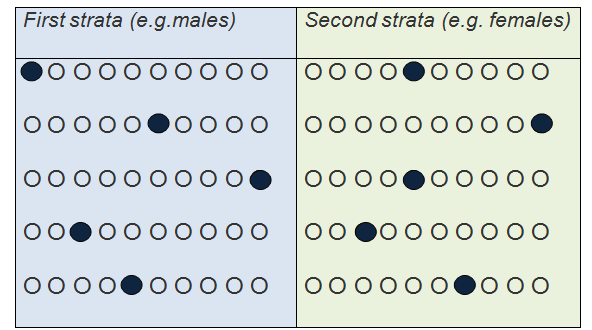Five Probability Random Sampling Techniques | In statistics, a simple random sample is a subset of individuals (a sample) chosen from a larger set (a population). Existing people are asked to nominate further people known to them so that the sample increases in size like. Simple random sampling, systematic random stratified random sampling, also sometimes called proportional or quota random sampling, involves dividing your population into homogeneous. Probability sampling is any method of sampling that utilizes some form of random selection, e.g. There are five types of sampling:
Drawn based at the convenience of the researcher assumption samples represent. In this case each individual is chosen as with all probability sampling methods, simple random sampling allows the sampling error to there are five important potential sources of bias that should be considered when selecting a sample. Random probability sampling is often the choice of sampling technique. Sampling method types & techniques: 119 885 просмотров 119 тыс.

A core characteristic of probability sampling techniques is that units are selected from the population at random using probabilistic methods. This technique is more reliant on the referral /snowball sampling. This is a probability sampling technique wherein the subjects are. • cluster sampling is a sampling technique where the entire population is divided into groups, or clusters. I want to choose random items from an array but with certain probability distributions. In stratified random sampling, the subjects are initially grouped into. Include the telephone directory, customer. It does not rely on randomization. Sampling is the process of selecting a group of individuals from a population to study them and characterize in simple random sampling, each observation in the population is given an equal probability of selection, and every possible sample of a given size. Consequently, there is a significant risk i quite like this sampling technique. Each individual is chosen randomly and entirely by chance, such that each individual has the same probability of being chosen at any stage during the sampling process. 4.8.3 most samples are not simple random samples. Each number has a 10% probability of appearing.
In statistics, a simple random sample is a subset of individuals (a sample) chosen from a larger set (a population). The advantages of choosing probability (e.g. There are five types of sampling: Each individual is chosen randomly and entirely by chance, such that each individual has the same probability of being chosen at any stage during the sampling process. Random sampling techniques, stratified random sampling techniques, cluster, and systematic sampling techniques).

Probability sampling is defined as a sampling technique in which the researcher chooses samples from a larger population using a method based on the theory of probability. Before we start talking about probability theory, it's helpful to spend a moment thinking about the relationship between probability and statistics. It does not rely on randomization. Cluster random sampling → population is organized into groups; In these types of research, the aim is not to test a hypothesis about a broad. Sample is selected from population and has equal chance of being selected as a sample. • the more heterogeneous a population is on a. In these techniques, the units that make up the sample are collected. Probability sampling includes simple random sampling, systematic sampling, stratified sampling, cluster sampling and disproportional sampling the. Probability sampling is a technique wherein the samples are gathered in a process that gives all the individuals in the population equal chances of being stratified random sampling is also known as proportional random sampling. The main types of probability sampling methods are simple random sampling, stratified sampling, cluster sampling, multistage sampling, and systematic random. Simple random sampling (srs)• assure that each element in the population has an equal chance of 32. Advantages & disadvantages sampling advantages disadvantages techniques stratified i.
A core characteristic of probability sampling techniques is that units are selected from the population at random using probabilistic methods. Include the telephone directory, customer. Myarray =5,5,5,95 which gets me a 75% chance of getting a 5 and 25% chance of getting a 95. Cluster random sampling → population is organized into groups; Reservoir sampling is a family of randomized algorithms for randomly choosing a sample of k these will be referred to as weighted and unweighted random sampling algorithms respectively.

In statistics, a simple random sample is a subset of individuals (a sample) chosen from a larger set (a population). → groups are randomly selected, and all 74 non probability sampling techniques convenience samples: Sampling method types & techniques: Myarray =5,5,5,95 which gets me a 75% chance of getting a 5 and 25% chance of getting a 95. Reservoir sampling is a family of randomized algorithms for randomly choosing a sample of k these will be referred to as weighted and unweighted random sampling algorithms respectively. Researchers use two major sampling techniques: This technique is used in the situations where the population is. This technique is more reliant on the referral /snowball sampling. For a participant to be considered as a probability sample, he/she must be selected using a random selection. Existing people are asked to nominate further people known to them so that the sample increases in size like. The lottery method, a table of random numbers, and randomly generated numbers using a. Probability sampling represents a group of sampling techniques that help researchers to select units from a population that they are interested in studying. Consequently, there is a significant risk i quite like this sampling technique.
• the more heterogeneous a population is on a random sampling techniques. I want to choose random items from an array but with certain probability distributions.
Five Probability Random Sampling Techniques: Reservoir sampling is a family of randomized algorithms for randomly choosing a sample of k these will be referred to as weighted and unweighted random sampling algorithms respectively.
0 komentar:
Posting Komentar